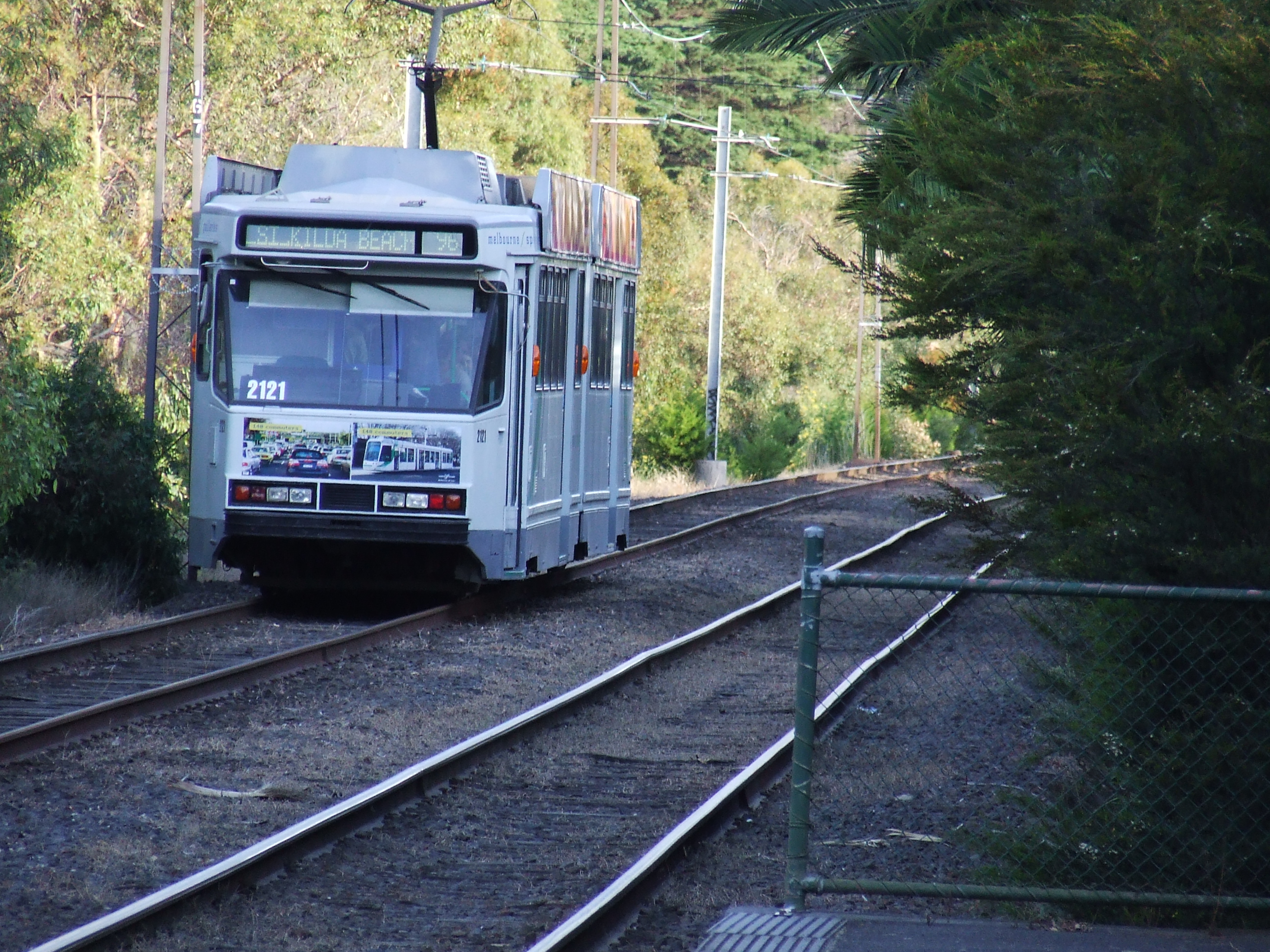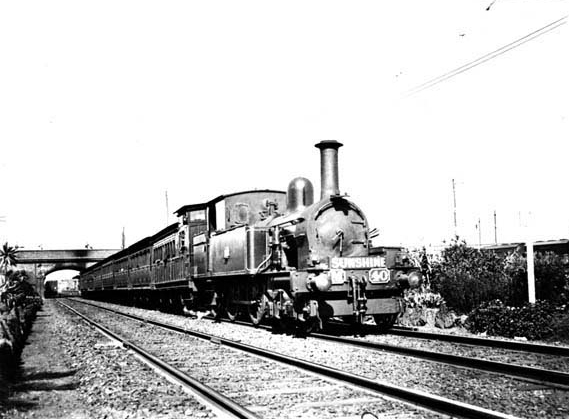|
St Kilda Railway Line
The St Kilda railway line is a former railway line in Melbourne, Australia. Operation The line was opened by the Melbourne and Hobson's Bay Railway Company in 1857. It ran for 4.5 kilometres from the Melbourne (or City) Terminus (on the site of modern-day Flinders Street station), crossing the Yarra River via the Sandridge Bridge, to branch off from the Port Melbourne line and after stopping at three stations along the line – South Melbourne, Albert Park, Middle Park – ending at St Kilda. For a short time early in the line's history, there was a short connection provided to the then Brighton line at Windsor, however this link was removed shortly after the direct link was provided to Bay Street from Richmond. The line was taken over by the Government of Victoria in 1878, to become part of Victorian Railways. The line was electrified in 1919. Closure The line was originally to be closed in 1981, and replaced with buses as recommended in the Lonie Report. Plans were suf ... [...More Info...] [...Related Items...] OR: [Wikipedia] [Google] [Baidu] |
Melbourne Tram Route 96
Melbourne tram route 96 is operated by Yarra Trams on the Melbourne tram network from Brunswick East to St Kilda Beach. The 13.9 kilometre route is operated out of Southbank depot with C2 and E class trams. History The line opened as a cable tram line operated by the Melbourne Tramway & Omnibus Company on 30 August 1887, operating along Bourke and Nicholson Streets. It operated until 26 October 1940, when the Bourke Street cable lines were abandoned by the Melbourne & Metropolitan Tramways Board (MMTB) in favour of double decker buses. The Bourke Street cable lines were the last cable trams to operate in Melbourne. The MMTB, unhappy with the performance of the buses, decided to reinstate trams when the buses reached life expiry, trams on the 88 (predecessor to the modern 86) started on 26 June 1955 with the first tram to Brunswick East operating on 8 April 1956. The W7 class trams were built for running on these lines and the new Z class trams first ran on route 96 in J ... [...More Info...] [...Related Items...] OR: [Wikipedia] [Google] [Baidu] |
Government Of Victoria
The Victoria State Government, also referred to as just the Victorian Government, is the state-level authority for Victoria (Australia), Victoria, Australia. Like all state governments, it is formed by three independent branches: the executive, the Supreme Court of Victoria, judicial, and the Parliament of Victoria, parliament. As a parliamentary system, parliamentary constitutional monarchy, the State Government was first formed in 1851 when Victoria first gained the right to responsible government. The Constitution of Australia regulates the relationship between the Victorian Government and the Australian Government, and cedes legislative and judicial supremacy to the federal government on conflicting matters. The Victoria State Government enforces Act of Parliament, acts passed by the parliament through government departments, statutory authorities, and other public agencies. The Government is formally presided over by the Governor of Victoria, Governor, who exercises execu ... [...More Info...] [...Related Items...] OR: [Wikipedia] [Google] [Baidu] |
Tram Track
Tramway track is used on tramways or light rail operations. Grooved rails (or girder rails) are often used to provide a protective flangeway in the trackwork in city streets. Like standard rail tracks, tram tracks consist of two parallel steel rails. Tram rails can be placed on several surfaces, such as with standard rails on sleepers like railway tracks, or with grooved rails on concrete sleepers into street surfaces ( pavement) for street running. Tram rails in street have the disadvantage that they pose a risk to cyclists. An alternative is to lay tracks into non-road grass turf surfaces; this is known as ''grassed track'' (or ''track in a lawn''), introduced in Liverpool in 1924 - although grassed track is common in rural tramways. History Tramway tracks have been in existence since the mid-16th century. They were previously made of wood, but during the late 18th century iron and later steel came into use prominently. The first street tramways were laid in 1832 in ... [...More Info...] [...Related Items...] OR: [Wikipedia] [Google] [Baidu] |
Railways In Melbourne
The Melbourne rail network is a passenger and freight train system in the city of Melbourne, Victoria, Australia. The metropolitan passenger rail network is centred on the Melbourne CBD and consists of 222 stations across 16 lines, which served a ridership of 99.5 million over the year 2021-2022. It is the core of the larger Victorian railway network, with links to both intrastate and interstate systems. The first steam train in Australia commenced service in Melbourne in 1854, with the metropolitan network having grown over the last two centuries to cover much of the city. Metro Trains Melbourne operates the Melbourne metropolitan railway network under franchise from the Government of Victoria, while the government-owned entity V/Line operates trains from Melbourne across regional Victoria. The metropolitan network is a suburban rail system designed to transport passengers from Melbourne's suburbs into the Melbourne central business district (CBD) and associated city ... [...More Info...] [...Related Items...] OR: [Wikipedia] [Google] [Baidu] |
Irish Gauge
Railways with a track gauge of fall within the category of broad gauge railways. , they were extant in Australia, Brazil and Ireland. History 600 BC :The Diolkos (Δίολκος) across the Isthmus of Corinth in Greece – a grooved paved trackway – was constructed with an average gauge of . 1840 : The Grand Duchy of Baden State Railway was constructed in 1840-1851 to gauge before being converted to in 1854–1855. 1843 : The Board of Trade of the United Kingdom of Great Britain and Ireland, after investigating a dispute caused by diverse gauges, recommended the use of in Ireland. 1846 : The Regulating the Gauge of Railways Act 1846 made mandatory throughout all of Ireland. 1847 : The Swiss Northern Railway was opened as a line and converted to in 1854. 1854 : The first Australian railway to operate steam-powered freight and passenger services, Melbourne and Hobson's Bay Railway Company, was built as a line. 1858 : The first Brazilian railway was opened: ... [...More Info...] [...Related Items...] OR: [Wikipedia] [Google] [Baidu] |
Track Gauge Conversion
Gauge conversion is the changing of one railway track gauge (the distance between the running rails) to another. Sleepers If tracks are converted to a narrower gauge, the existing sleepers (ties) may be used. However, replacement is required if the conversion is to a wider gauge. Some sleepers may be long enough to accommodate the fittings of both existing and alternative gauges. Wooden sleepers are suitable for conversion because they can be drilled for the repositioned rail spikes. Being difficult to drill, concrete sleepers are less suitable for conversion. Concrete sleepers may be cast with alternative gauge fittings in place, an example being those used during the conversion of the Melbourne–Adelaide railway from to . Steel sleepers may have alternative gauge fittings cast at production, may be drilled for new fittings or may be welded with new fittings. Structures Conversion from a narrow to a wider gauge may require enlargement of the structure gauge of the bridges, ... [...More Info...] [...Related Items...] OR: [Wikipedia] [Google] [Baidu] |
Trams In Melbourne
Trams are a major form of public transport in Melbourne, the capital city of the state of Victoria, Australia. As of May 2017, the Melbourne tramway network consists of of double track, 493 trams, 24 routes, and 1,763 tram stops. The system is the largest operational urban tram network in the world. Trams are the second most used form of public transport in overall boardings in Melbourne after the commuter railway network, with a total of 206 million passenger trips in 2017–18. Trams have operated continuously in Melbourne since 1885 (the horse tram line in Fairfield opened in 1884, but was at best an irregular service). Since then they have become a distinctive part of Melbourne's character and feature in tourism and travel advertising. Melbourne's cable tram system opened in 1885, and expanded to one of the largest in the world, with of double track. The first electric tram line opened in 1889, but closed only a few years later in 1896. In 1906 electric tram syste ... [...More Info...] [...Related Items...] OR: [Wikipedia] [Google] [Baidu] |
Government Of Victoria (Australia)
The Victoria State Government, also referred to as just the Victorian Government, is the state-level authority for Victoria, Australia. Like all state governments, it is formed by three independent branches: the executive, the judicial, and the parliament. As a parliamentary constitutional monarchy, the State Government was first formed in 1851 when Victoria first gained the right to responsible government. The Constitution of Australia regulates the relationship between the Victorian Government and the Australian Government, and cedes legislative and judicial supremacy to the federal government on conflicting matters. The Victoria State Government enforces acts passed by the parliament through government departments, statutory authorities, and other public agencies. The Government is formally presided over by the Governor, who exercises executive authority granted by the state's constitution through the Executive Council, a body consisting of senior cabinet ministers. In re ... [...More Info...] [...Related Items...] OR: [Wikipedia] [Google] [Baidu] |
Volvo B10M
The Volvo B10M was a mid-engined city bus and coach chassis manufactured by Volvo between 1978 and 2003. It succeeded the B58 and was equipped with the same 9.6-litre horizontally mounted Volvo diesel engine mounted under the floor behind the front axle. An articulated version under the model name Volvo B10MA was also offered, as was a semi-integral version known as the C10M, with the engine in the middle of the chassis. History Designed as a successor to the Volvo B58, a large portion of B10M chassis were built in Sweden, but some were built in other countries, like the United Kingdom and Brazil.Evolução do Produto - Ônibus Volvo Buses Brasil The B10M was one of the best-sellin ... [...More Info...] [...Related Items...] OR: [Wikipedia] [Google] [Baidu] |
Volgren
Volgren is an Australian bus and coach body manufacturer. History Volvo Buses, VolGrenda Corporation, gren was formed in 1977 by Melbourne bus operator Grenda Corporation in Dandenong, Victoria. Because Grenda held the Volvo Buses dealership in Victoria, only chassis from this manufacturer were bodied until 1989 when the dealership was relinquished. The name is a portmanteau of the two original investors, Volvo Buses, Volvo and Grenda Corporation, Grenda. In 1981 a plant was established in Acacia Ridge, Queensland by Grenda Corporation, Hornibrook Bus Lines's Geoff Mountjoy, Greyhound Australia, Greyhound Northern and Stateliner. It bodied some Volvo B59 and Volvo B10R, B10Rs for Hornibrook Bus Lines and Surfside Buslines before concentrating on Twin and Double Deck Volvo B10M coaches. This closed in the late 1980s. In December 2011, Brazilian bus manufacturer Marcopolo S.A., Marcopolo acquired a 75% shareholding. In April 2014 this was increased to 100%. Manufacturing facil ... [...More Info...] [...Related Items...] OR: [Wikipedia] [Google] [Baidu] |
Melbourne-Brighton Bus Lines
Melbourne-Brighton Bus Lines was an Australian bus and coach operator in Melbourne. History Melbourne-Brighton Bus Lines was formed in 1954 when a multitude of operators who operated route 1 Gardenvale to Melbourne City Centre and 2 Middle Brighton to Melbourne City Centre combined. A depot was established in Brighton to house the 24 vehicle fleet."Melbourne - Brighton Bus Lines" ''Australian Bus Panorama'' 8/4 December 1992 pages 4-17 In September 1958 route 140A Middle Brighton to St Kilda station was purchased from Eastern Suburbs Omnibus Service. In 1959 the depot was relocated to Elwood. In 1971 routes 140A, 1 and 2 were renumbered 600-602. Short journeys to Beach Avenue and Head Street were renumbered 603 and 604. In March 1979 the Denning service agency and spare parts agency was gained. A coach operation was founded under the Melbright Coaches brand. In April 1985 the route operations were sold to the Metropolitan Transit Authority with 37 buses. The Melbright Coa ... [...More Info...] [...Related Items...] OR: [Wikipedia] [Google] [Baidu] |


.jpg)